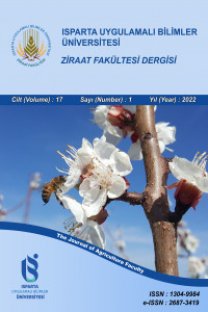Usability of Shallow Groundwater in Irrigated Agriculture: A Case Study From Turkey
Shallow Groundwater, Water Saving, Watertable, Irrigation Practices, SPSSWIN
Usability of Shallow Groundwater in Irrigated Agriculture: A Case Study From Turkey
Shallow Groundwater, Watertable, Irrigation Practices, SPSSWIN,
___
- Akkaya A.S.T, Gundogdu K.S 2007. Mapping Multi-Year Groundwater Depth Patterns from Time Series Analyses of Seasonally Lowest Depth-to-Groundwater Maps in Irrigation Areas. Polish J. of Environ. Stud. Vol. 16, No. 2 (2007), p:183-190.
- Ayars J. E, Christen E. W, Soppe R. W, Meyer W. S. 2006. The resource potential of in- situ shallow ground water use in irrigated agriculture: a review. Irrigation Science. 24: 147- 160.DOI 10.1007/s00271 -005-0003-y.
- DMİ, 2017. Some meteorological data in field of research. DMI (Turkish State Meteorological Service)-TURKEY.
- DSI, 2005. Groundwater Monitoring Guidebook for irrigated Lands of Turkey. State Hydraulic Works, Ankara, Turkey.
- Grimes D.W., Henderson, D.W. 1984. Developing the resource potential of a shallow ground water. California Water Resources Bulletin:1 88.
- Güngör Y. and Erözel Z. 1994. Drenaj ve Arazi Islahı. Ankara Üniversitesi. Ziraat Fakültesi Yayınları No:1341. Ders Kitabı:389.(in Turkish)
- Kruse E.G., Young D.A., Champion, D.F. 1985. Effects of saline watertable on corn irrigation:444-453. IN C.G. Keyes and T.J. Ward(ed). Development and Management aspects of Irrigation and Drainage Systems. (Proceedings of Specialty Conference ed.) ASCE, New york.
- Mahajan G. 2008. Evaluation and Development of Groundwater. ISBN 978-81-313-0339 9:70-75.
- Meyer W.S., White B., Smith D. 1996. Water use of lucerne over shallow watertables in Australia, Proceedings of International Conference, Evapotranspiration and Irrigation Scheduling, nov. 3-6, 1996. San Antonio, Texas, Ed. C.R. Camp, E.J. Sadler, R.E. Yoder, ASAE. Joseph, MI, p: 1140-1145.
- Nwadukwe P.O., Abdulmumin S., Aroray Y. and IKE I.F. 1989.Effects of irrigation frequency and water table depths on root growth and yield of tomato in a soil. Agricultural Water Management 16(3):241-249.
- De Ridder N.A. 1994. Groundwater Investigations in: Drainage Principles and Applications. Edited by H.P. Ritzema. International Institute for Land Reclamation and Improvement P.O. Box 45. 6700 AA Wageningen the Netherlands.
- Smedema L.K., Rycroft D.W. 1983. Land Drainage. Planning and Design of Agricultural Drainage Systems. Batsford Academic and Educational Ltd.:1-376. London.
- Smedema L.K. 1990. Natural Salinity Hazards of Irrigation Development in (Semi-) Arid Regions. Proceedings of Symposium on Land Drainage for Salinity Control in Arid and Semi-Arid Regions. ICID_CIID. Cairo. Egypt.
- Torres J.S. and Hanks R.J. 1989. Modelling water table contribution to crop evapotranspiration. Irrigation Science 10(4):265-279.
- Wesström I., Messing, I., Linnér H., Lindström, J. 2001.Controlled Drainage – Effects on Drain Outflow and Water Quality. Agricultural water Management, Volume 47, Issue 2, p:85-100.
- ISSN: 1304-9984
- Yayın Aralığı: Yılda 2 Sayı
- Başlangıç: 2006
- Yayıncı: Isparta Uygulamalı Bilimler Üniversitesi
Yeşim BOZKURT ÇOLAK, Attila YAZAR, Serpil TANGOLAR, Gülşen DURAKTEKİN, Engin GÖNEN
Antalya Ortalama Sıcaklık Verisinde Gidişlerin Yeni Bir Gidiş Analiz Yöntemi İle Belirlenmesi
Mete ÖZFİDANER, Duygu ŞAPOLYO, Fatih TOPALOĞLU
Konya Koşullarında Ayçiçeğinde Farklı Sulama Seviyeleri ile Su Stresinin Verim ve Kaliteye Etkisi
Arzu GÜNDÜZ, Oğuz GÜNDÜZ, Mehmet Ali DÜNDAR, Osman ÇAĞIRGAN, Şerife ÇAY
Isparta İli Sulama Kooperatiflerinde Sulama İşletmeciliğinin Değerlendirilmesi
Zafer Ali SERBEŞ, Umut OKKAN, Şerafettin AŞIK
Berkant ÖDEMİŞ, Derya KAZGÖZ CANDEMİR, Kerem KARAZİNCİR
Sakarya İli Taraklı İlçesi Sulama Suyu Kaynaklarının Su Kalitesinin Belirlenmesi
Saliha DORAK, Barış Bülent AŞIK
Yeşim AHİ, Korkmaz BELLİTÜRK, Hüseyin Tevfik GÜLTAŞ
Alanya Yöresi Muz Bahçelerinin Beslenme Durumlarının Belirlenmesi
